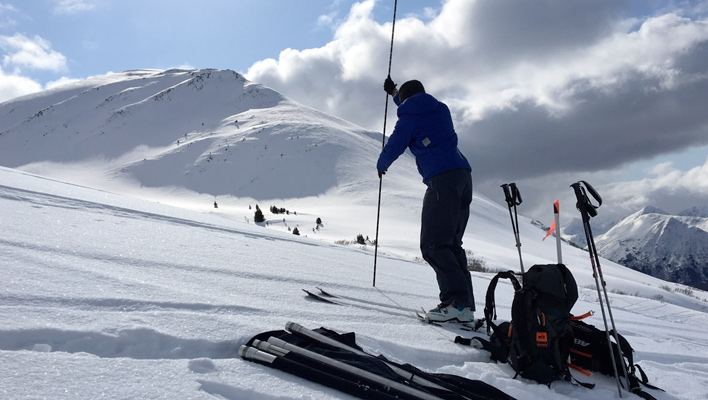Data collection for scientific research can be a tedious task, especially when it comes to gathering information from remote, wintry climates. But a group of scientists based out of Oregon State University, the University of Washington and University of Alaska have joined forces to mobilize an army of backcountry citizen scientist to gather crowd-sourced snow-depth data.

Gabe Wolken makes snow-depth measurements at Turnagain Pass, Alaska. [Photo] Katreen Wikstrom.
Professor David Hill at Oregon State University is one of the scientists working on this new crowd-sourced data-collection model, and he sees great potential for this new way of activating citizens in the field to get a large amount of data—and quickly—so the information can then be plugged into a number of different models.
“In the wintertime, you have all kinds of people—snowshoers, hikers, snowboarders, skiers, snowmobilers—going out in the snow, so if we can get them to gather data, that’s going to increase the set of data we have to improve our models,” Hill says. “And as we’ve seen in Alaska, the data collected through this program have cut the errors in our models dramatically.”
The project got its start in Alaska four years ago near Thompson Pass, due to its status as an extremely popular backcountry area. But the citizen-science community for this project has since grown. In December 2017 Hill and his colleagues started reaching out to backcountry communities in the western United States like those of the Sierra Nevada and Rocky Mountains to further expand their database.
“As this database grows, we can provide better information about the snowpack to any stakeholders who are interested, whether it’s local avalanche forecasters, watershed councils or any organization that has an interest in a better understanding of how much snow is out there and where it is,” Hill explains.
Another benefit of this particular citizen-science project is the low barrier to entry. “It takes no training, takes low-cost equipment and takes under 60 seconds to do,” Hill says. “You get your probe out, take the depth measurement, punch it into your phone, and you’re done…. Some citizen-science projects require a fair bit of training and specialized equipment, whereas with this one, we realized that it wasn’t going to work unless we made it as simple as possible.”
When it comes down to it, that’s what Hill is striving for: an easy way to get people interested in science and in engaging with their surrounding environment.
“We’re trying to get people interested in snow science; we’re trying to get them to understand that this is where their water comes from in the summertime and that contributing to a science project is important, cool and helpful,” Hill says. “It’s been a really awesome year.”
—
Learn more about the project and get involved at communitysnowobs.org.










Related posts: